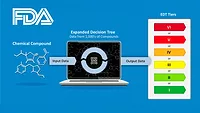FDA Outlines its Developing Systematic Post-Market Review Process for Chemicals in Food

Image credit: Freepik
On Wednesday, September 25, 2024, the U.S. Food and Drug Administration (FDA) held a public meeting to discuss the ongoing development of an enhanced, systematic process for the post-market assessment of chemicals in food, during which new details about FDA’s approach were revealed.
FDA’s work to increase its oversight of substances being used by food manufacturers comes on the heels of a fast-moving wave of state and federal legislation targeting additives and ingredients of public concern, such as “generally recognized as safe” (GRAS) substances, synthetic food dyes, and other chemicals. This increasing legislative attention to food additives regulation began with the California Food Safety Act, which was passed in October 2023 and bans four toxic additives from foods sold or manufactured in the state, and has recently escalated to the Congressional level with bills like the Toxic Free Food Act, which intends to overhaul FDA’s GRAS process allowing the introduction of unsafe ingredients to the food supply.
During a previous FDA roundtable discussion, Deputy Commissioner for Human Foods James (Jim) Jones, who will lead the restructured FDA Human Foods Program coming into effect in October, commented on the proliferation of food additives regulation and its potential to undermine FDA authority. “Ideally, when the federal government is more active in the regulatory process, then the states don't feel as much need to act,” he said, promising that FDA would more attentive to the issue of food additives under his leadership.
Mr. Jones is seemingly delivering on this promise as work on FDA’s enhanced post-market food chemical assessment advances. As outlined in the September 25 public meeting and a supplementary discussion paper, the developing review process will encompass GRAS substances, substances used in food contact materials, color additives, and unintentionally added chemicals (e.g., environmental contaminants). Not included in the scope of the post-market review process are assessments of chemicals conducted in response to public safety incidents (i.e., for chemicals implicated in a foodborne illness outbreak).
The Post-Market Chemical Review Process, Outlined
Because some post-market assessments will be more complex and resource-intensive than others, the post-market review process will be divided into two types of assessments—Focused and Comprehensive. For all chemicals, FDA envisions the post-market assessment process to begin with a three-part review of information, involving:
- Food Chemical Signal Monitoring: FDA will identify new information through monitoring of multiple sources, such as submissions to FDA, scientific publications, international and U.S. regulatory activities, adverse event reports, news reports and trade press, and social media
- Triage: FDA will conduct a preliminary quality and impact assessment of information obtained through food chemical signal monitoring to determine the need for post-market assessment
- Fit-for-Purpose Decision: FDA will decide whether to conduct a Focused or Comprehensive Assessment based on the complexity of the assessment, taking into account a number of factors (e.g., whether lab work or data collection activities are required, the strength of the existing body of evidence, if the substance is of significant public health interest, existing deadlines for the agency to make a determination, etc.).
Focused Assessments
Focused Assessments will be limited in scope and will be conducted by FDA without formal external engagement, and will therefore be conducted relatively quickly (within four months to one year, excluding risk management review and actions). This type of assessment will be four-part:
- Scope/Problem Formulation: FDA will define the chemical substance and establish the scope of review
- Scientific Risk and Safety Assessment: FDA will assess whether information about a chemical suggests a possible safety/public health concern, and whether intentionally added substances meet the “reasonable certainty of no harm” standard or if actual/estimated exposures exceed a safe level
- Risk Management Review: FDA will determine whether action is necessary and outline possible mitigation strategies and associated benefits to public health, and may also identify the need for further research or a full comprehensive assessment
- Communication of Conclusions and Implementation of Risk Management Actions: FDA will communicate conclusions and take any appropriate risk management action, and depending on conclusions, the chemical may be referred for prioritization as part of a Comprehensive Assessment.
Comprehensive Assessments
Comprehensive Assessments will be more complex and resource-intensive than Focused Assessments and may take years to complete, requiring external engagement (e.g., peer review), and risk communication will be critical throughout the process. Comprehensive Assessments will be six-part, and FDA will especially engage the public to inform its work during the Scope/Problem Formulation and Draft Risk Assessment stages. Comprehensive Assessments will be inducted as follows:
- Prioritization: FDA experts will rank individual chemicals selected for Comprehensive Assessment based on a Multi-Criteria Decision Analysis scoring method to determine their relative priority against other chemicals in food, likely prioritizing chemicals that are severely toxic with potential life-threatening effects (e.g., cancer), are found in foods commonly consumed by vulnerable populations, chemicals for which changes in exposure have occurred, and for which newly available science indicates a concern to public health
- Scope/Problem Formulation: FDA will define the chemical substance and establish the scope of the review, considering public engagement to inform the agency’s work
- Draft Scientific Risk and Safety Assessment: FDA will assess whether existing information about a chemical suggests a safety concern, considering adverse health effects, dietary exposure, an estimation of likely risk to relevant populations, and data gaps or research needs; FDA will determine whether intentionally added substances meet the “reasonable certainty of no harm” standard; and for contaminants, FDA will assess the risk of the contaminant in food to determine if its presence needs to be limited or reduced to ensure public safety
- Risk Management Review: FDA will determine whether action is necessary to protect public health and, if so, consider available options for risk management, at which point FDA may request new data from stakeholders, collect additional analytical or exposure information, or conduct exposure or safety studies
- Concurrence with FDA Human Foods Program Leadership: FDA experts responsible for the Draft Scientific Assessment and Risk Management Review will brief Human Foods Program leadership on their scientific conclusions, and options and recommendations for risk management
- Public Final Assessment and Risk Management Action: After considering external and internal feedback, FDA will publicize a Final Scientific Assessment, initiate appropriate risk management actions (e.g., recalls and enforcement actions), and, depending on the risk management action (e.g., if FDA revokes authorization for an additive), provide opportunity for public comment.
Public Comment on Proposed Process for Post-Market Chemical Review
Looking for quick answers on food safety topics?
Try Ask FSM, our new smart AI search tool.
Ask FSM →
FDA is welcoming public comments on the outlined post-market chemical review process, and is asking for specific input on public engagement, review frequency and mechanisms, the potential integration of an advisory committee review, the appropriateness of the Fit-for-Purpose Decision Tree, the appropriateness of the Prioritization of Risks scheme, and the appropriateness of the two-pronged Focused and Comprehensive approaches.
Comments can be submitted here until December 6, 2024.
Update, November 11, 2024: FDA has extended the comment period for the proposed enhanced systematic process for its post-market assessment of chemicals in food until January 21, 2025.









